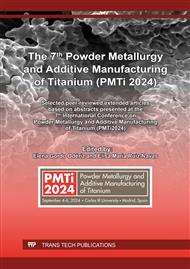p.41
p.49
p.57
p.65
p.73
p.83
p.93
p.103
p.113
Interaction of Binder and Powder in Processing of Titanium by MEX-AM
Abstract:
For the processing of metal powders by Metal Injection Moulding (MIM) or indirect methods of Additive Manufacturing (AM), such as material extrusion (MEX-AM) polymers of different kinds are employed. Usually, the task of these polymers is to enable the shaping of a certain geometry and to maintain this shape down to the first cohesive effects of sintering. Nowadays, for the production of metal parts one goal is to get rid of the polymer as complete as possible. Another possibility is to use the polymer or at least part of it, mainly the carbon, for the metallurgical process of forming the final part in sintering as a process of heat treatment. Titanium is a metal, which is reacting with carbon easily. The question in focus here is how to utilise the carbon or some of it in the powder metallurgical processing of titanium. For first steps into this question, we selected two different powders, CPTi and TiH2, and mixed them with two different polymers, polypropylene PP and low-density polyethylene LDPE. As a compatibilizer stearic acid SA was used. The polymers were selected because they are normally used as backbone in binder systems, and show a significantly different thermal degradation behaviour. Thus, the amount and type of carbon during thermal degradation could be expected to be different. The study comprises the preparation of polymer-powder blendings with up to 80 vol.% powder to resemble the conditions after solvent debinding; the shaping in discs, and TG-DTA experiments in air and in Ar to find out the temperature of backbone removal (Tr). Isothermal experiments are also done to know about the polymer removal with time. The different interaction of the polymers with the titanium powders is investigated, with a special attention to the interaction of hydride decomposition and polymer degradation. Keywords: Metal Injection Moulding; indirect Additive Manufacturing; titanium and titanium alloys; powder-polymer interaction
Info:
Periodical:
Pages:
93-102
Citation:
Online since:
March 2025
Price:
Сopyright:
© 2025 Trans Tech Publications Ltd. All Rights Reserved
Share:
Citation:



